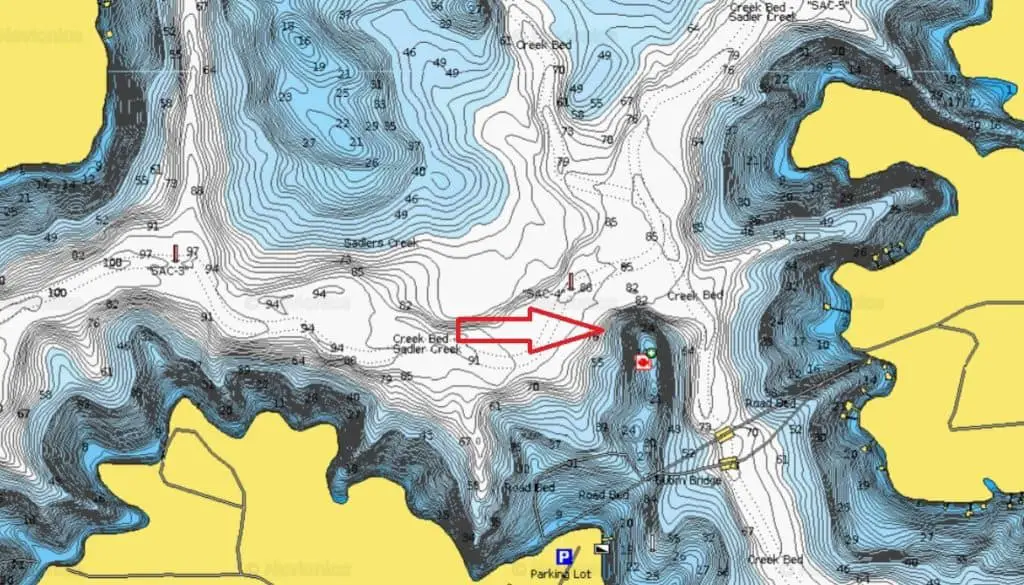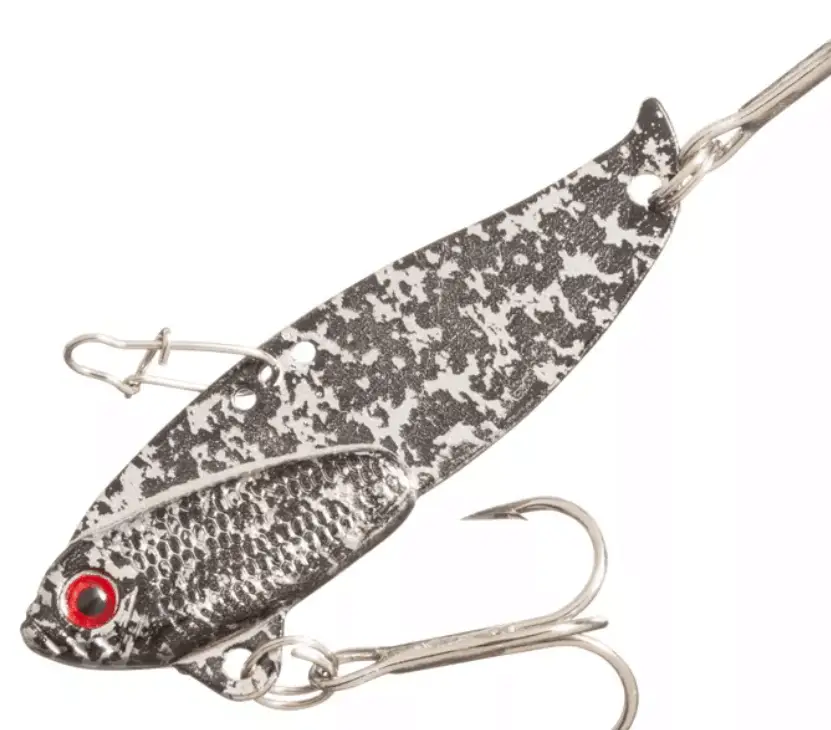
Many bass anglers in northern climates face a “difficult” time of year as the cold weather approaches. They realize that their bass fishing time is over for a while, pack up their gear and boats, and are destined to watch old youtube clips of fishing, maintaining their boats and equipment, or anything else that keeps them in touch with their fishing habit.
However, seasoned bass fishermen know that being ready to fish after ice out can pay off in big ways.
To locate and catch bass after ice out, target deep structure using Navionics and your electronics. Look for warmer water and bait when possible. Use slow-moving baits like a hair jig, tube, drop shot, or a jerkbait worked with long pauses for sluggish bass.
Bass fishing after ice out can be challenging for even the most seasoned fishermen. However, there are particular tips and tricks for catching bass after the ice melts.
8 of the Best Lures for Ice Out Bass Fishing
1. Use Bait Imitating Jigs for Ice Out Bass
Dropping a jig that looks like the target prey for the time of year is perfect for catching smallmouth bass after ice out. A 4-inch bait that imitates a minnow or herring on a jig head is one bait that fits the bill. Drop the bait vertically on fish that you find using your electronics. For a good reason, hair jigs are also a favorite of many bass anglers. Check out an interesting variation of the hair jig by Berkley on Amazon here.
2. Drop Shot Soft Plastics for Sluggish Bass
Drop shotting can be one of the best iced-out Smallmouth techniques. Using a soft plastic that mimics a 3 to 5-inch minnow is ideal. Drop-shotting allows the bait to stay in front of a sluggish bass for a longer period of time. Live Target’s drop shot minnow is incredibly life-like (see it on Amazon here)
3. Fish Blade Baits to Tempt Ice Out Bass
Blade baits are known to work wonders on finicky and cold smallmouth bass. Be sure to match the lure’s color and size to the lake’s predominant baitfish. This tactic works well for fish located in approximately 20-30 feet of water connected to a particular piece of deep water structure.
4. Finesse Fish for Ice Out Bass with Tube Baits
Tube baits are also a go-to bait for many during this dynamic time of year. Tube baits are a finesse application that smallmouth can’t resist. Fish ‘em slow, and you’ll have a good shot of hooking up with post-ice-out bass. I’ve seen great success with Zoom tube baits (amazon).
5. Let a Lipless Crankbaits Sink to the Strike Zone
Lipless crankbaits should also be included in your arsenal of ice-out lures. They are versatile lures that can be fished at different depths with many different retrieves. Upon hitting the water after a cast, the lipless crankbait sinks so anglers can allow it to drop to their desired depth (the depth at which bass are holding as evidenced by electronics or past experience). They are best fished along ledges or submerged lines of vegetation.
6. Slow roll a Deep Diving Crankbait
Slow-rolling deep-diving crankbaits can be a great strategy as well for bass fishing after ice melts. They are best fished on ledges, drop-offs, and points close to areas where bass will eventually move up to spawn. Slow is the operative word here. Bass aren’t ready to feed very aggressively yet, so slowing down is important to elicit a bite.
7. Jerkbaits for Ice Out Smallmouth Bass
Jerkbaits are one of the best lures for ice-out bass. Smallmouth begin moving to shallow water as soon as the water starts to heat up (usually above 50 degrees). Slower baits that mimic common prey prevail after the ice out and before the spawn starts. Megabass makes one of the best jerkbaits on the market. Although priced on the high side, they are EXTREMELY effective. Check them out on Amazon here. Try working a jerkbait with long pauses between each twitch — as long as two or three seconds and sometimes up to ten or fifteen seconds. Read more on five areas you can fish a jerkbait.
8. Catch Ice Out Bass with a Weighted Fluke
A weighted fluke is also an excellent technique for ice out Smallmouth as it can mimic the right size minnows that bass are hungry for after not eating much before the ice out. The key here is to add enough weight to the fluke enough so it sinks to the strike zone but not so much that it sinks to the bottom. You want it somewhat suspended. Jerkbaits and weighted flukes are unusual in that they are built to stay in a strike zone for a more extended period of time. For this precise reason, these baits can be so effective for cold-water bass.
What is Ice Out?
Simply put, ice out occurs when the ice on a body of water thaws and disappears. This usually begins to happen when there is a sustained time of warmer days allowing water temps to start to warm after a consistent period of cold weather.
The Department of Natural Resources of Minnesota describes ice out in several ways,
“The definition of lake ice out can vary from lake to lake. For the citizen observers reporting data, ice out occurs when the lake is completely free of ice. Or, it may be when it is possible to navigate from point A to point B. Ice out may also be when a lake is 90 percent free of ice. Observers use consistent criteria from year to year when reporting lake ice out dates.”
Source
11 Great Tips to Help You Find Bass After Ice Out
Much like us, bass like to find warmth in the midst of cold. Consider the following 11 tips and particular areas for finding bass after an ice out.
1. Look for Sunny Banks for Warmer Water.
Look for banks in your body of water that get the most sun, as warmer water attracts the bass. A few extra degrees can mean a big deal to cold-blooded creatures like bass.
2. Find Deep Structure for Cold Water Bass.
Cold water means that bass move to deep water structure. Use your electronics to locate ledges, brush piles, piles of rocks, sunken boats, ditches, humps, or any other sudden change in bottom contour or elevation. Bass like to relate to areas where they will eventually spawn, so check secondary points near potential spawning areas.
Bass tend to follow specific patterns during the wintertime, even without ice covering a lake. Check out Bass Fishing Insider’s Complete Guide on How to Catch Fish in the Winter.
3. Don’t Overlook Shallow Water. It May be Warmer.
Check the backs of creeks, coves, and other shallow water areas where the sun can heat the water a little more quickly. You may find that ice melts faster there, and bass (and their prey) may migrate to these areas at least temporarily to escape the colder water.
4. Darker Bottoms Hold Heat and Warm Up Faster.
Fish like warm water and will be attracted to those warmer areas.
5. Boulders and Rock Piles Warm Up and Hold Heat.
Underwater features like rock piles, boulders, and concrete hold heat and attract bass. Once again, bass are looking for the warmest water they can find.
6. Look for Warm Water Entry Spots in a Lake.
Look for areas in the lake where warm water enters the lake, as iced-out smallmouth bass love warm water. If there is not an obvious area like a warm water discharge point, head to the area of water closest to the dam if there is one. Water nearest to dams is usually some of the warmest in the lake.
7. Use Navionics to Find Ledges, Points, and Ditches.
Use Navionics, Lakemaster, or any other favorite chart tool to find likely underwater ledges, points, ditches, roadbeds, and other travel lanes for fish. Your electronics are very important for fishing offshore structure and should be used, if available, to locate bass during this time of the year.
There is a free version of Navionics that you can access here. Click on the Chartviewer tab at the top. I found this main lake point on Lake Hartwell that would be a good spot to look for offshore bass.

8. Look for Riprap or Other Rocks Along the Shoreline.
Riprap or other shoreline rock holds heat and warms up the surrounding water.
9. Be on the Lookout for New Vegetation.
Any new growth, even if minimal, means extra oxygen in that area for bass.
10. Check out Marinas, Lagoons, and Other Small Bays.
Some areas of the lake tend to warm faster than others. Marinas, lagoons, and other smaller bodies of water are great areas to look for bass after an ice out because there is a smaller pool of water which tends to warm faster relative to larger areas of the lake.
11. Follow the Baitfish.
Baitfish can be found anywhere, but pay particular attention to two unique situations. Look for the first sign that perch are preparing to spawn. Bass will be sure to follow them as they are a favorite meal for a post-ice-out bass. Second, look for herring or other baitfish grouped up offshore. Find those schools, and you’ll find bass.
How Do Bass React to Ice Out?
Bass fishing typically takes a turn in the right direction for anglers after ice out. Before ice out occurs, bass are usually hunkered down deep, lethargic, and relatively inactive. This also means that they have been less pressured by boating and fishermen because the lakes have been inaccessible to many people.
Smallmouth tend to group and congregate on structure like humps and brush piles after an ice out in large numbers. Largemouth like to dart to shallow water that tends to warm even faster but don’t think smallmouth are immune to the shallow move as well in the right situations.
Deeper lakes warm more slowly, whereas shallow lakes generally tend to warm up a bit faster. The takeaway is that bass will stick to their winter-holding areas longer on deeper-water lakes. On these lakes, focus more on deep water structures.
How Deep Should You Look for Bass after an Ice Out
The ideal depth to start looking for fish depends on the average depth in your particular body of water. I would suggest using a zig-zag tapering method. Start deep in an area near a spawning flat. Use your electronics to graph an area by working your way toward the bank in long, straight lines zig-zagging back and forth in approximately 50-75 yard stretches. Each stretch should be angled toward the shore and take you closer to the shoreline as you work the pattern.
Watch the fishfinder for underwater structure or cover and look for bass holding on to those features. Eventually, you may be able to use this technique to identify the depth at which the fish are holding.
Another tactic is to identify travel lanes. Bass fishing after ice melts is similar to other times of the year. Fish follow travel lanes just like we do when we travel on roads and highways.
Pay attention for underwater structures that can serve as fish travel lanes. Old roadbeds, weedlines, ditches, ledges, and the like can all serve as travel lanes. Bass will follow these lanes as they make their way from their cold water holding areas to warmer areas of the lake or as they prepare to move into their home for spawning. These travel routes are a significant KEY to catching fish after an ice out.
When deciding on the best lures for ice-out bass fishing, remember that bass are still lethargic, so placing baits vertically on top of fish works well. Using jigs and drop shots are effective vertical tactics. Additionally, working a jerkbait with long pauses in between twitches or slow-rolling a crankbait along ledges or other deep structure can pay off.
A Few More Specifics …
Since bass are cold-blooded and still a little slow from prolonged exposure to cold water, vertical presentation may be your best line of attack. Finicky bass may be better temped by something dropped close to their position as they are not ready nor willing to move a great distance to grab their next meal. They are working to conserve energy and not moving as much as usual because their metabolism is slower.
I recommend smaller profile baits and lures for the best bass fishing success after ice melts. Lighter line and spinning reels are likely your best bet for catching bass on more finesse applications after ice out. Fluorocarbon is also highly recommended to prevent finicky fish from being spooked by something that they don’t feel looks natural. (Lighter-pound test braid is fine with a fluoro leader.) If you want information on the best spinning reels, check out the gear page here for info on the best spinning reels for bass fishing.
Because iced out smallmouth bass tend to school up after ice out, there are great opportunities to catch bass in large numbers.
By using some of the bait and tactics above and slowing down a bit, you’ll increase the odds of catching good numbers of fish.
Special Tip for Largemouth Bass After Ice Out
While most attention on ice out fishing is on Smallmouth, Largemouth bass also deserve attention.
Largemouth tend to head to the shallow a bit sooner than Smallmouth. As discussed previously, they typically follow travel lanes, so finding the “fish highways” is critical to your success.

When ice out fishing for largemouth bass cruising the shallow waters after an ice out, a slow presentation works best. Senkos, wacky rigged worms, or even a drop shot (yes, a drop shot in shallow water) are good candidates for a slower, more systematic approach to shallow-water largemouth who have just moved up from their deep haunts.
Insider Tip
Remember that smallmouth and largemouth bass are not in a super aggressive mood right after an ice out. The bite may be barely noticeable. Use lighter line and gear and the most sensitive rod you can manage so you can best detect bites.
Final Word
After sitting dormant for a season of cold, snow, and ice, anglers can seize the opportunity to catch large amounts of hungry bass after ice out. At the first sign of a warming trend, brace for impact. It’s time to cast a line and ready yourself to get your fish on!


